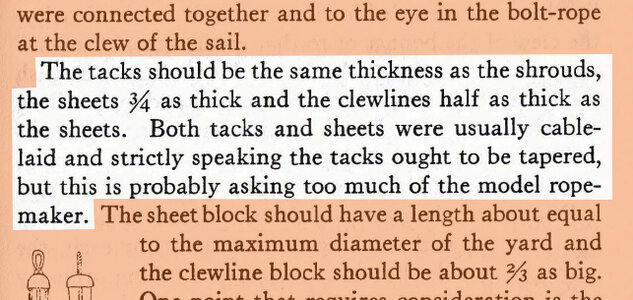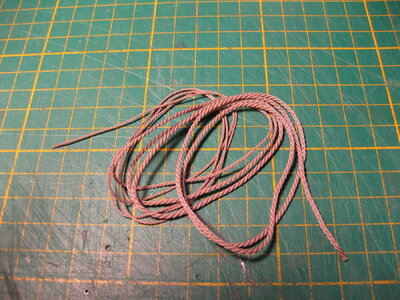Steel says that sheets and tacks are cabled. Lees, Mondfeld and Petersson don't mention it. can anyone help me with a decision?
You are using an out of date browser. It may not display this or other websites correctly.
You should upgrade or use an alternative browser.
You should upgrade or use an alternative browser.
- Joined
- Aug 8, 2019
- Messages
- 4,540
- Points
- 688


This is what Anderson writes. And yes these are cables because they have the same size as shrouds (sheets 3/4 of the shrouds).
And they are also tapered, but that is difficult to make. And you see this never on a model. It is not impossible to make. I did it on my Prins Willem

Here is how I did it
VOC ship The Prins Willem (scale 1:75) Year 1651
Paul, Jim, Brad, ConsNZ, Kurt and shota thanks for the kind words. These are more then welcome. Also the likes are a warm welcome. No I didn't read them, Even the movie I didn't seen. I downloaded the ebooks of James Corey - Expanse (11) and put them in my reading list. Thanks for the advice...
shipsofscale.com
Thanks Stephan My Steel says says sheets are 4", tacks are 5" and shrouds are 7" for the fore course but that's not a real issue. I guess I have to make some "S" rope.
- Joined
- Aug 8, 2019
- Messages
- 4,540
- Points
- 688

That could be indeed the measurements for a 18th century ship. Anderson is talking about 16 and 17th centuryMy Steel says says sheets are 4", tacks are 5" and shrouds are 7" for the fore course
You can als have this in thought. The maximum diameter of rope is 73 mm. It is never thicker. If you want thicker then it was normal to make a cable.
a cable with less diameter then 73 mm. is called a cablet. That last is only done if it was necessary that it has to be cable laid.
Last edited:
I've always wondered why they wanted different twists. Must be the same weird thinking that made car makers put left hand thread on the lug nuts back n the 50's
- Joined
- Aug 8, 2019
- Messages
- 4,540
- Points
- 688

Read this
You can find this all back in my topic about rope. the first 2 post are explain everything.
But first I want to tell you something about the history of ropes and how it was made the last few thousands of years. The method is still too today the same.
Rope has been made for centuries. A piece of ship's rope, which was already 2000 years old, was found during excavations of the Roman forts in Velsen (the Netherlands). U can find a picture of it here: tweeduizend-jaar-oud-touw The piece was about 30cm long and about 3cm thick. It was made of hemp, which makes it special because this material decays quickly. The composition was almost identical to the present day. Hemp has therefore been used for centuries to make rope and is particularly suitable for this purpose. The fibres are spun into threads and from these threads yarns are made by twisting them. In earlier times it was quickly discovered that rope twisted clockwise is the strongest rope. That is why you find mainly right-hand twine in history. Today we know that this is due to the natural shape of the cells in the hemp fibre. By twisting it clockwise, you go with the lay of the cells and the fibre retains its natural resilience and strength. Bill Fronzaglia wrote in The History of Rope: "Even the standardization of the Right Hand Lay rope dates back to the early days of rope production, when it was known that Hemp retains more strength when the yarn is twisted to the right. This resulted in a left hand strand, and a right hand rope. It wasn't until modern times that microscopic examination of the plant illustrated that the structure of the plant has a natural twist that causes this effect" (Source: the-history-of-rope )
The fibres spun into threads are called yarns. They are twist in a clockwise direction (Z-twist). From the yarns, counterclockwise (S-twist) strands are then twist and these are used to make clockwise (Z-twist) rope, Hawser laid rope.
You can find this all back in my topic about rope. the first 2 post are explain everything.
Make your rope on a rope walk
I did a lot of research on how to make rope on a rope walk and build my own rope walk. I love to share my experience with you. The quality of the rope delivered in your kit is not always of high quality. Fluffy, badly made so that you can better use it to tie up your old paper than to rig your...
shipsofscale.com

